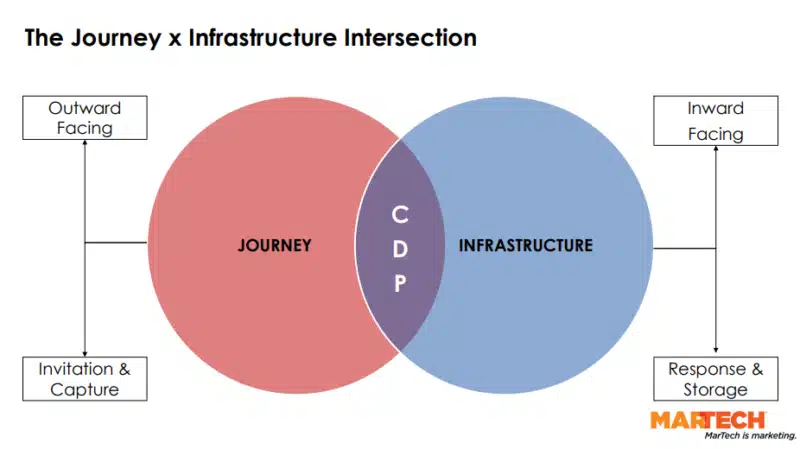How to ID and organize data with a new CDP
To get the most out of your CDP, make sure the customer journey and your company’s internal infrastructure are aligned.
When implementing a new CDP, companies need a practical plan to identify and organize the data ingested into it.
“The CDP is great, but it’s not magic,” said Amanda Cardona, owner of ALC Renaissance Consulting at The MarTech Conference. “So, it needs to have a clear ingestion process in order for it to be able to help you activate in an efficient and clean way.”
CDP at the journey-infrastructure intersection
The concept that marketers need to keep in mind when planning out the CDP implementation is called the “journey-infrastructure intersection,” Cardona explained. The CDP resides at this intersection.
Where does all this data come from? Cardona divides the data landscape into two main areas.
First, there is data that comes from the customer journey, where prospects and customers have opportunities to share first-party data with your company.
Captured from these outward-facing data sources, the data is then organized internally. In order to implement the CDP effectively, these two sources need to be aligned.

Understanding how the data flows into the CDP from these two sources will help make sure that the data is clean and actionable, according to Cardona.
Let’s take a closer look at these two areas.
Customer journey data
The customer journey data is all the data that comes from outward-facing opportunities.
“It could be from a contact, prospect or visitor, whatever you call your specific customer,” said Cardona.
They interact with different touchpoints in the digital experience where they are given an opportunity to share information. These can be found on a website, or delivered through social media. It could also be an email signup form.
Each of these actions that the customer takes places them at a specific point in the customer journey. Customers that contact your organization by asking questions or by making purchases are obviously more engaged customers than those who simply visit the site and create an account without taking any further action.
Dig deeper: How to build customer profiles using a CDP
In preparing to implement a CDP, marketing team members and other stakeholders should have a full understanding of all these capture points. They will be weighted differently depending on the organization. So, as an organization, you should be asking what it means, for instance, if the customer or prospect engages with your company on social media.
“Is social media simply an informational or acquisition play?” Cardona asked. “If somebody were to fill out a lead form internally, does that qualify them as a warmer lead? You want to think about mapping out that journey.”
Internal infrastructure for captured data
This leads to how that captured data is structured internally within your organization.
“Once that data is captured, what are you doing with it?” Cardona asked. “Where is it going? Do you know the names of the systems that are capturing it? Do you know the names of the data fields?”
In mapping out the internal infrastructure, first you should consider the systems that are capturing the data. Are they third-party systems? Are there integrations? On what kinds of files is the data stored?
With different proprietary systems that capture the data, there are also distinct rules for data sharing guidance and governance.
After each of these systems is identified, the implementation team should also identify who is using the data. Different taxonomies could be used by different teams, such as marketing or sales. That’s why it’s important to know how the data is going to be used, and also what the nomenclature is in the data fields, related to how the data is organized.
Finally, it’s important also to know when the data is used. In which parts of the martech stack is the data activated for marketing functions?
“Your visitors leave invaluable information if you make it simple for them,” said Cardona. “Thinking about and laying out the structure of where all those opportunities are will be really helpful for your CDP implementation process.”
Dig deeper: How CDPs transform donor experience for a nonprofit
Related stories
New on MarTech